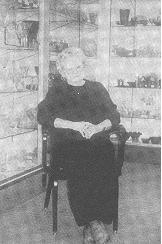National Cambridge Collectors, Inc.
A non-profit 501(c)(3) organization.

Worker of the Month - Martha Spear Barlow
by Lorraine Weinman
 Martha Spear Barlow was the head cook
at the Cambridge Glass Factory. She operated the cafeteria there
for over five years. Along with Martha, her sister-in-law, Vera
Shivers, and Martha's husband Gerald Spear, saw to the everyday
operation of the cafeteria.
Martha Spear Barlow was the head cook
at the Cambridge Glass Factory. She operated the cafeteria there
for over five years. Along with Martha, her sister-in-law, Vera
Shivers, and Martha's husband Gerald Spear, saw to the everyday
operation of the cafeteria.
The cafeteria was subcontracted out to her. She paid so much a month for the cafeteria. Usually arriving before 5:00 a.m., she would start making pies. About 160 pies were made daily; 100 usually being fruit pies. The cafeteria itself was very plain and easy to keep clean according to Martha. The cafeteria was a separate building located toward the back of the main factory part. The pond was just outside the cafeteria. Wood tables and chairs on a cement floor with no carpeting is what workers found while eating in the cafeteria. it was all one big room that could seat 75 to 100 people though it was never full. Martha Washington tumblers were used as well as Cambridge salt and pepper shakers and sugar bowls. These were known to disappear all the time. Mostly paper plates were used. This meant that only glasses, coffee cups and pots and pans were all that needed to be washed. The work in the cafeteria usually was not finished until 4:00 or 5:00 in the afternoon.
The Cambridge Glass Co. was providing the cafeteria as a service to their employees. Martha got a percentage of what the cafeteria took in. The company furnished the gas and electricity as well as the pots and pans. John Tremoulis had operated the cafeteria before she did.
Everything served in the cafeteria was homemade. She says there was always plenty of meat, ham and beans, baked chicken and dressing, and a lot of sandwiches. There was a cooler with bottled Coke. Ice tea, coffee and milk were other beverages available. Sandwiches ranged in price from 5 cents to 15 cents. A bowl of soup was 10 cents; coffee, 5 cents; hot dog, 5 cents; ham sandwich, 15 cents; baked steak, 15 to 20 cents. There were all kinds of cream-filled pies. Martha says that they went crazy over the chiffon pies! Cafeteria tokens were used by some of the employees. Whoever bought them, bought them through the payroll department. Meal tickets were also available.
Martha explained that many people took their food back to where they worked. In fact, much of the food was fixed for take out. Many departments sent one person down around 10:30, before the 11:00 serving time. That person would have maybe 10 or 12 orders. She said the etching department seemed to have the largest orders.
In closing, Martha shared an interesting story of how a popular recipe came into being. She was making raisin pies one day. Had some raisin filling left over and some leftover lemon and meringue. She put the raisin filling in the crust and then put in the lemon and meringue. After first making this pie, she couldn't make enough of them!
We really appreciated Martha sharing these fascinating stories with us. The cafeteria was an important part to the lives of those in the factory and an interesting new area for us to learn about.